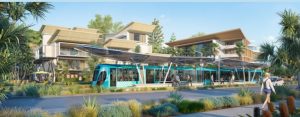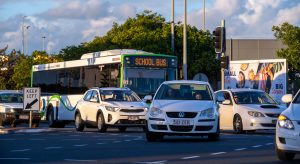Experts warn the Sunshine Coast could “come to a standstill” and lose its liveability unless residents jumped on board with a mass transit system to keep people moving in the future.
As council voted to progress its plan to get the Coast moving, Urban planners said mass transit was the biggest transport trend around the world being pursued by cities grappling with fast-growing populations.
And they warned unless the region started planning now for the next 50 years, the region’s roads would become clogged with cars.
It’s estimated another 200,000 people will move to the Coast in the next two decades, adding thousands of vehicles to the road network.
“The reality is, if you don’t have mass transit to be able to move people, particularly in linear cities like the Sunshine Coast, it becomes very difficult and congestion and traffic movement are going to become very difficult,” said Urbis director Peter Hyland, a leading land-use strategist.
“It’s part of the evolution of cities around the world. The biggest movement that is happening now is mass transit systems and looking at how they can move people.”
Mr Hyland, who is also a director of planning at the University of Queensland’s School of Architecture, said to not explore a mass transit option for the Coast would be “negligent” and people in the future would look back at the wasted opportunity.
- Related story: How the Coast plans to move with the times
Mr Hyland, who lived in Singapore for five years before returning to Brisbane, said the city of 5.7 million people was a world-leading example of seamless public transport where 90 per cent of the population did not own a car.
He said if the Sunshine Coast wanted to continue attracting new industry and innovative businesses it needed to provide the kind of transport that the tech-savvy and green-conscious generations wanted.
Mr Hyland said young people did not need convincing to use public transport if it was fast, efficient and affordable, but older Australians were the hardest to convert.

He urged residents over the age of 50 to consider the needs of future generations who would be the ones catching public transport to work.
The council’s public feedback on its Mass Transit Project found most residents under 50 years were satisfied with all five transport options, while most people over 51 were dissatisfied.
“The under 50s are the ones that are going to be moving more than the over 50s,” Mr Hyland said.
“The next generation are the ones we’ve got to consider. They’re the ones who are going to be going to work, raising families.
“When you’re over 50 you’re probably not travelling as much. So I think they’ve got to respect the next generation coming through.
“We were fortunate that traffic volumes weren’t as high (for older generations in the past) but you’ve only got to look at the traffic coming down the Sunshine Coast now on any day — it’s not going to get easier.”
Help keep independent and fair Sunshine Coast news coming by subscribing to our free daily news feed. All it requires is your name and email. See SUBSCRIBE at the top of this article
Mr Hyland said a modern mass transit system would make the Coast more attractive to innovative workers and businesses.
“One of the first questions the new age workers ask is ‘what sort of public transport is available?’ The next generation of workers, the people who are coming through now, are looking for options other than car movements.
“They have expectations, so if you want to be a modern attractive location for high-tech workers, attracting businesses, you’ve got to be able to show them a pattern of movement where they’re not just relying on a car as their only way of transport.

Emeritus Professor Peter Spearritt, from the University of Queensland, said public transport infrastructure was not for the residents of today, but for people who would be living on the Coast in the next 50 years.
Professor Spearritt, a specialist in urban history whose interests include coastal urbanisation, said it was “not plausible” to continue through the next five decades just by building more roads, and buses were only effective if they had their own lane.
“Unless you’ve got a fixed track system of some sort, the area will almost come to standstill in the next 20 years or so,” he warned.
“Another very pertinent aspect is … at any one point at least one-third of people can’t drive — because they’re under 17, or older people who no longer drive or, increasingly, people who can’t afford a car.
“To have a large and growing urban area without adequate public transport is, in effect, disenfranchising about one-third of the population.”
Both university experts said a well-designed transport corridor would attract more people to live along the route, but people shouldn’t be afraid of increased density.
“There’s no doubt if you have good transit systems, people will want to live close to them and that’s what you want, but once again density doesn’t have to be done badly,” Mr Hyland said.
“I’m sure the Sunshine Coast can do medium density well. People don’t need to be afraid of a bit of density but the days when everyone was going to live in a detached house — the next generation is not necessarily looking for that.”





